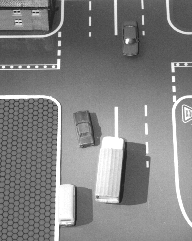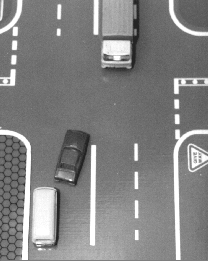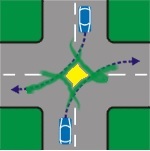|
6.
CORNERS (The 10/10/1 - 20/20/2 - System) |
Learner drivers
often don't have a concept of how fast to approach or turn a
corner. Beginners approach too fast,
giving the instructing person a fright. Some stop far too short of the
junction or intersection; others err on the slow side until they gain confidence
and experience to choose a safe speed.
The correct speed depends on the following 5 factors:
| 1.
The driverís experience |
Beginners must approach far slower than a learner
about to take the test. |
| 2.
Visibility
|
How far into the side road can you see?
No view - don't go! |
| 3.
Give-Way rules |
When facing a give way sign or approaching from the stem of a
T-junction, drive much slower. |
| 4.
Left or right turn?
|
Left turn
involve giving way to one
direction only. Therefore, right turns must be approached slower. |
| 5.
The vehicle
|
Allow time for gear changing in a manual vehicle. |
|
The 10/10/1 -
20/20/2 system applies only in urban traffic, not on country
roads, where speeds vary according to the shape of the corner.
In urban traffic beginners are advised to stop before turning
from the mouth of a T-junction, at a give-way sign or
roundabout.
Depending on
their progress, however, as they drive confidently at the speed
of other traffic, the 10/10/1 - 20/20/2 is a good formula for
turning corners.
Approaching a
blind corner, where the driver cannot see other traffic and
therefore needs to slow right down use 10101. It means 10
metres before the corner slow down to 10 km/h and
select 1st gear!
Approaching
an open corner, where visibility is good and/or you don't need
to give way to anyone, 20 metres before the turn, slow
to 20 km/h and select 2nd gear.
In an automatic vehicle the approach is almost identical, except
thereís no gear to change. Keep your foot on or over the brake,
ready to stop, until a clear view is obtained.
|
| When
turning left, position the vehicle parallel to the kerb as you approach
your turn. You are less of a problem to traffic behind.
Shown here: how
NOT to turn. Note how the truck crosses dangerously into
oncoming traffic. >>> |
 |
| Turning
right, also approach in a parallel path, and position vehicle in
the left of centre position.
Shown here: how NOT
to position or turn. Note the sedan badly stopped at an angle. Should the
van run in its back, there would be a nasty head-on crash >>> |
 |
|
When
turning right rotate the steering wheel quickly clockwise, but bring
it back early and slowly.
For
left turn it's the opposite: Depending on the shape of the turn,
rotate the steering wheel slowly
left. Just before completing the turn, bring it back quickly
to continue in a straight path.
In
order to avoid 'cutting a corner' (right turn only) do not turn the
steering wheel until your can see into the road you
are entering! Starting a right turn too soon means risking a collision with
traffic approaching the junction or intersection. You will be
driving dangerously on the wrong side of the road!
|
In
Australia right turn traffic completes the turn with a 'diamond
turn': Traffic takes a path from the left of centre to the left of
centre of the roads. The paths of four vehicles create a diamond
shape. > |
 |
|
|
HOME EMAIL
US |
Our
information could vary in your part of the world. We recommend
you use above information in conjunction with a professional
driving instructor.
All
articles Copyright Dieter Fischer 2001 / Site revised 2020.
|